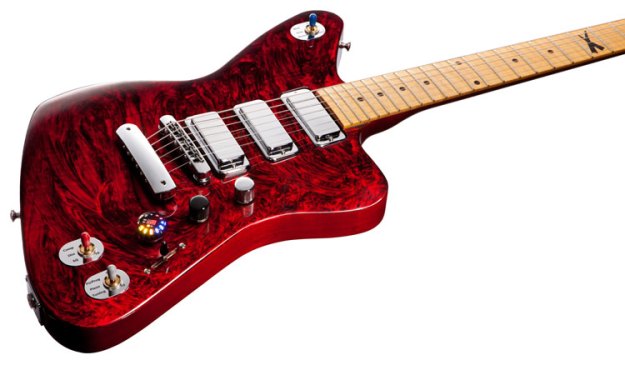
In rock music, innovations take a long time. The first electric guitars that actually stayed in tune and worked well for stage performance were produced in the 1950s, and the basic design – fretboard, pick-ups, tuning knobs, a quarter-inch jack – has not changed much in the last 60 years.
The Gibson Firebird X is the latest “digital guitar” that attempts to change some of the basic mechanics of a guitar. While you can play the instrument immediately and chords and notes work the same as always, you can change the tone of the Firebird X in countless ways – some more dramatic than others.

For $5,570, the Gibson Firebird X is intended for serious musicians, performers, and recording gurus. A few issues with the initial setup caused a few headaches, but they were easily redeemed by the remarkable quality and extensive features of this inspiring digital instrument.
New things to learn
Anyone used to Apple products might be confused by the initial setup. Unpacking the Gibson Firebird X and all the various parts that need to connect takes some time and thought. (Interestingly enough, once you figure out how everything connects, the system works extremely well.)
Part of the initial frustration is exacerbated by the guitar itself, which has several knobs and switches that seem arcane at first. Most of them are designed to give you that perfect tone or to emulate the lush effects you’ve heard on albums by, say, Snow Patrol or the band Thursday. Gibson says that over 2,000 tones are possible. You can flip switches to use all three picks-ups, two of them, or just one. Most of the knobs look like those on a regular guitar, but have a more dramatic effect.

Once you figure out the knobs, you then have to connect all the pedals and a break-out box. Flexibility is good, since there is no specific order for how you position the pedals. Confusingly, while the pedals have quarter-inch jacks, you do not need to use them – the guitar connects to a break-out box called a G-Node, and then the pedals connect to each other and to the guitar over Bluetooth. To power up the main foot pedal, you press all the way down on the volume pedal. Switching between effects or recording and playing loops with the second pedal is also a bit confusing. For example, you might need to consult the manual to see that you double-tap on a switch to record a loop.

Another problem with the setup is that every device uses a rechargeable battery – they look exactly like those you’d use in a camcorder. The batteries lasted about 45 minutes after a full charge, which is not a major problem if you have spares handy (Gibson included an extra four or five extra batteries with our review kit). You can also use 9-volt batteries as a back-up. Still, battery life could be a problem for some.
Ready to rock
That said, once you have configured the pedals and the interface, charged and installed the batteries, and installed the included software (Guitar Rig 4 and Ableton Live Lite 8 Gibson Studio Edition), the Firebird X is a smart rig for live performance and recording because you can quickly change tones. In several songs we recorded with the guitar, we found we could switch between a tight-sounding jazz sound and then flick over to a heavy distortion sound with tons of reverb. In many ways, the Firebird X is like having multiple guitars in one – and even multiple amps – for serious musicians.
Tuning the guitar worked perfectly, and we could even use alternative tunings (like a drop D) without much hassle. For anyone who wants to learn about guitar, we still recommend learning how to tune because it teaches you the basic mechanics. Relying too much on the auto tuning function means you won’t know as much about keeping the guitar in tune as you play – for example, bending notes in a guitar riff or playing alternative chords.

The Firebird X has almost too many features to mention – the dynamic range of the guitar is over 100dB, it uses a Freescale multi-processor with reliable electronics, and can even emulate a Gibson J-45. You can share patches you develop on the guitar with other Firebird X owners on a social network. Using a plug-in for the Firebird, you can even create your own modulation and reverb settings. There’s a charging couplet that links both pedals together using magnets so you only need AC power for one pedal. Even the Firebird X case is almost indestructible – you can drop one from a six-story building.
The real question is whether the guitar is worth the $5,570 price tag. In general, the guitar itself matches the quality and playability of any guitar around – but even high-end guitars usually cost about $3,000. The extra gear that comes with the Firebird X adds to the value, but the clincher for us was when we started changing the tones on the guitar using the switches and knobs. They just make the sound change dramatically, and that’s not possible on other models we’ve tried.

For those who need that tonal flexibility, ease of control, and extra loop recording options, the Firebird X is unique in that no other guitar really comes close. If you tend to use the same tones when you play, other guitars can offer those basic features. And, you can do much of the patch creation and recording capability with software – or a really good pedal effects board. But the Firebird X puts all of these features into one rig. Like a fine German sportcars, the Gibson Firebird X has no equal.


